2016 NISSAN PATHFINDER heater
[x] Cancel search: heaterPage 15 of 540
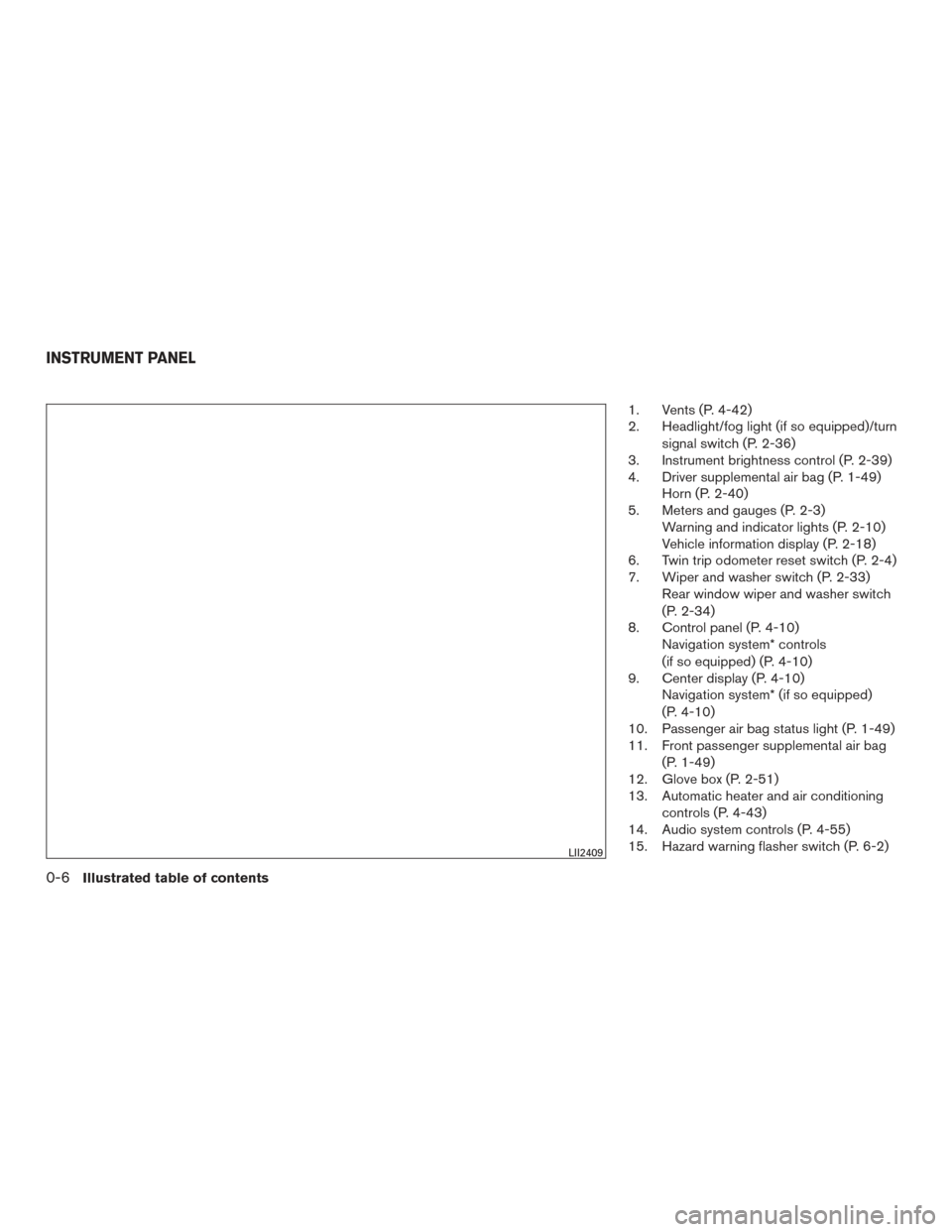
1. Vents (P. 4-42)
2. Headlight/fog light (if so equipped)/turnsignal switch (P. 2-36)
3. Instrument brightness control (P. 2-39)
4. Driver supplemental air bag (P. 1-49) Horn (P. 2-40)
5. Meters and gauges (P. 2-3) Warning and indicator lights (P. 2-10)
Vehicle information display (P. 2-18)
6. Twin trip odometer reset switch (P. 2-4)
7. Wiper and washer switch (P. 2-33) Rear window wiper and washer switch
(P. 2-34)
8. Control panel (P. 4-10) Navigation system* controls
(if so equipped) (P. 4-10)
9. Center display (P. 4-10) Navigation system* (if so equipped)
(P. 4-10)
10. Passenger air bag status light (P. 1-49)
11. Front passenger supplemental air bag
(P. 1-49)
12. Glove box (P. 2-51)
13. Automatic heater and air conditioning
controls (P. 4-43)
14. Audio system controls (P. 4-55)
15. Hazard warning flasher switch (P. 6-2)
LII2409
INSTRUMENT PANEL
0-6Illustrated table of contents
Page 91 of 540
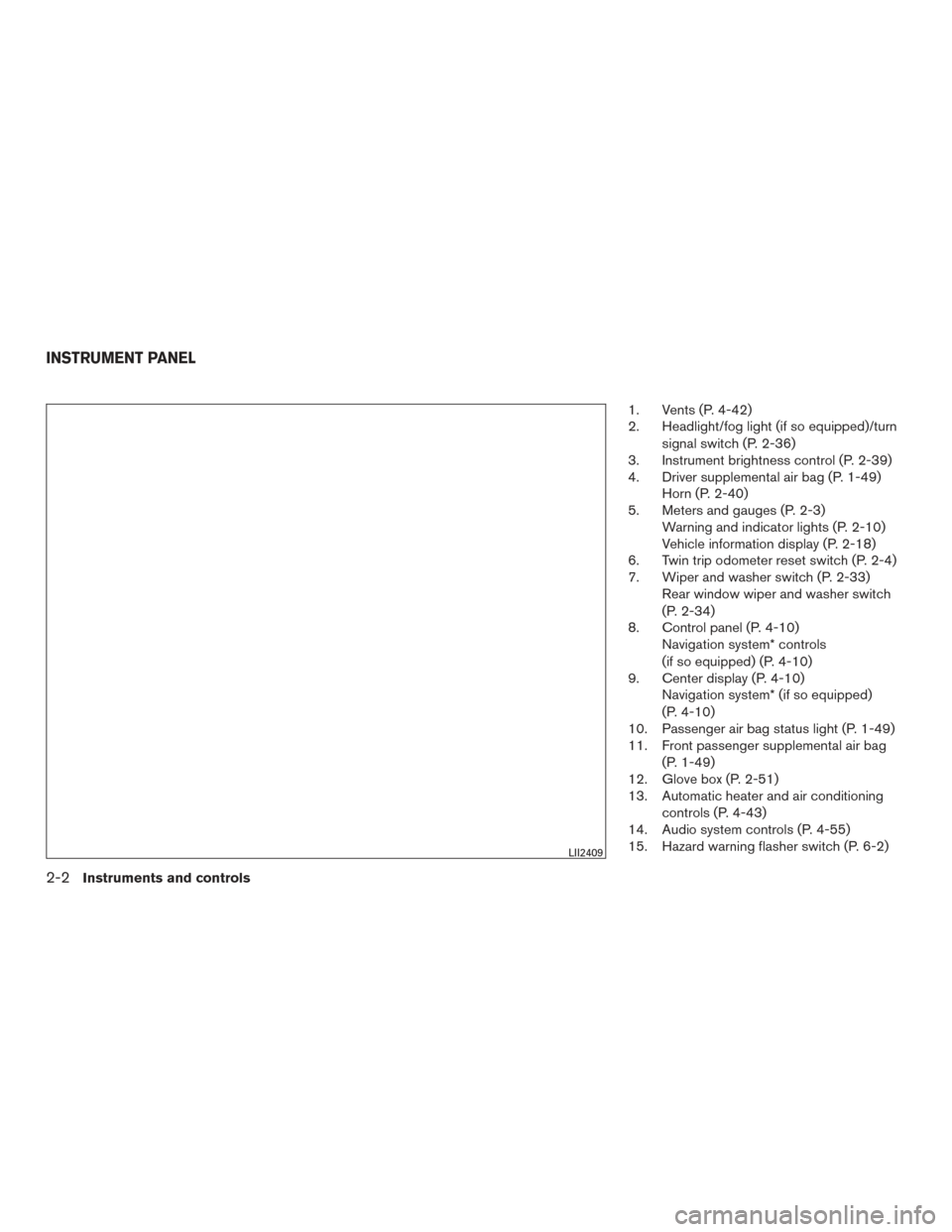
1. Vents (P. 4-42)
2. Headlight/fog light (if so equipped)/turnsignal switch (P. 2-36)
3. Instrument brightness control (P. 2-39)
4. Driver supplemental air bag (P. 1-49) Horn (P. 2-40)
5. Meters and gauges (P. 2-3) Warning and indicator lights (P. 2-10)
Vehicle information display (P. 2-18)
6. Twin trip odometer reset switch (P. 2-4)
7. Wiper and washer switch (P. 2-33) Rear window wiper and washer switch
(P. 2-34)
8. Control panel (P. 4-10) Navigation system* controls
(if so equipped) (P. 4-10)
9. Center display (P. 4-10) Navigation system* (if so equipped)
(P. 4-10)
10. Passenger air bag status light (P. 1-49)
11. Front passenger supplemental air bag
(P. 1-49)
12. Glove box (P. 2-51)
13. Automatic heater and air conditioning
controls (P. 4-43)
14. Audio system controls (P. 4-55)
15. Hazard warning flasher switch (P. 6-2)
LII2409
INSTRUMENT PANEL
2-2Instruments and controls
Page 129 of 540
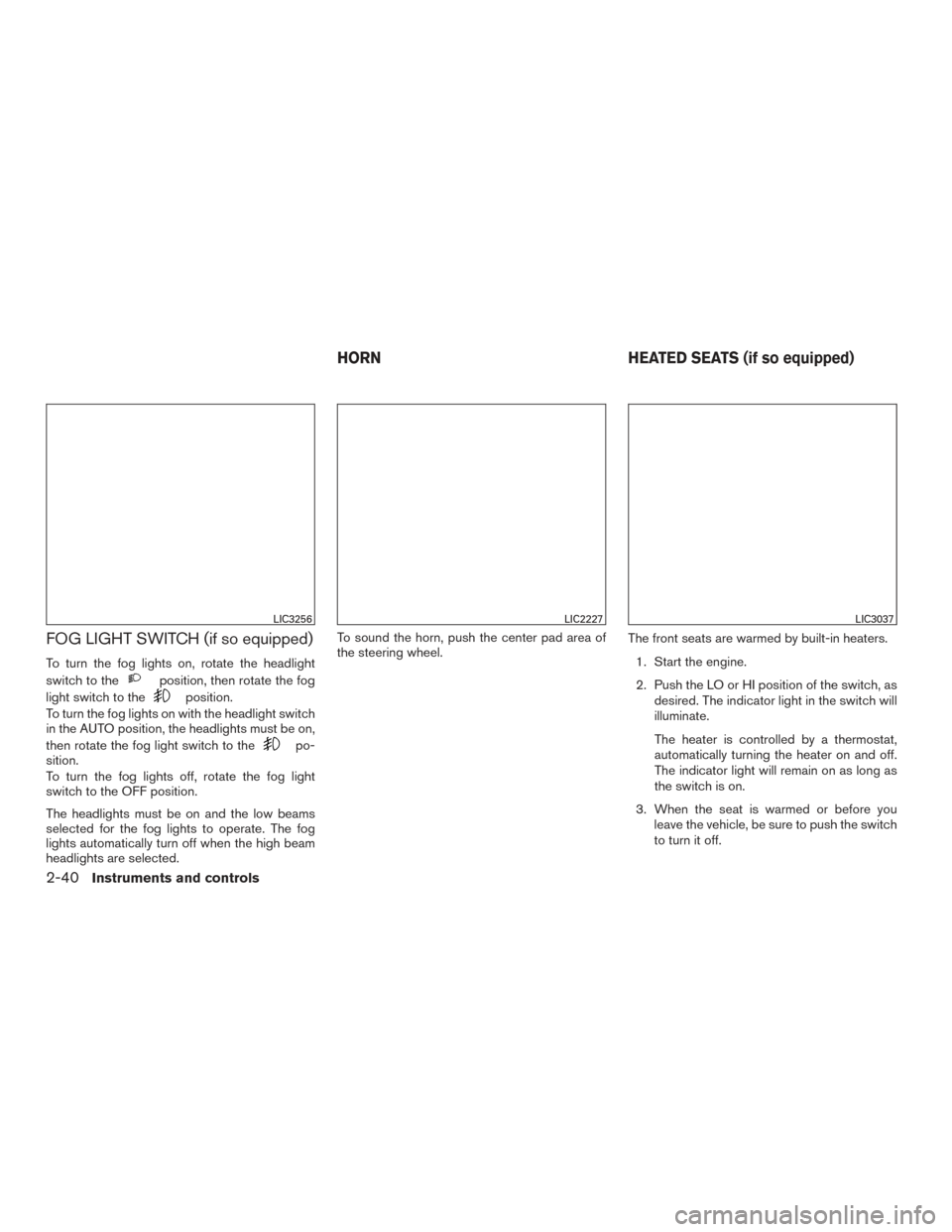
FOG LIGHT SWITCH (if so equipped)
To turn the fog lights on, rotate the headlight
switch to the
position, then rotate the fog
light switch to the
position.
To turn the fog lights on with the headlight switch
in the AUTO position, the headlights must be on,
then rotate the fog light switch to the
po-
sition.
To turn the fog lights off, rotate the fog light
switch to the OFF position.
The headlights must be on and the low beams
selected for the fog lights to operate. The fog
lights automatically turn off when the high beam
headlights are selected. To sound the horn, push the center pad area of
the steering wheel.
The front seats are warmed by built-in heaters.
1. Start the engine.
2. Push the LO or HI position of the switch, as desired. The indicator light in the switch will
illuminate.
The heater is controlled by a thermostat,
automatically turning the heater on and off.
The indicator light will remain on as long as
the switch is on.
3. When the seat is warmed or before you leave the vehicle, be sure to push the switch
to turn it off.
LIC3256LIC2227LIC3037
HORN HEATED SEATS (if so equipped)
2-40Instruments and controls
Page 130 of 540
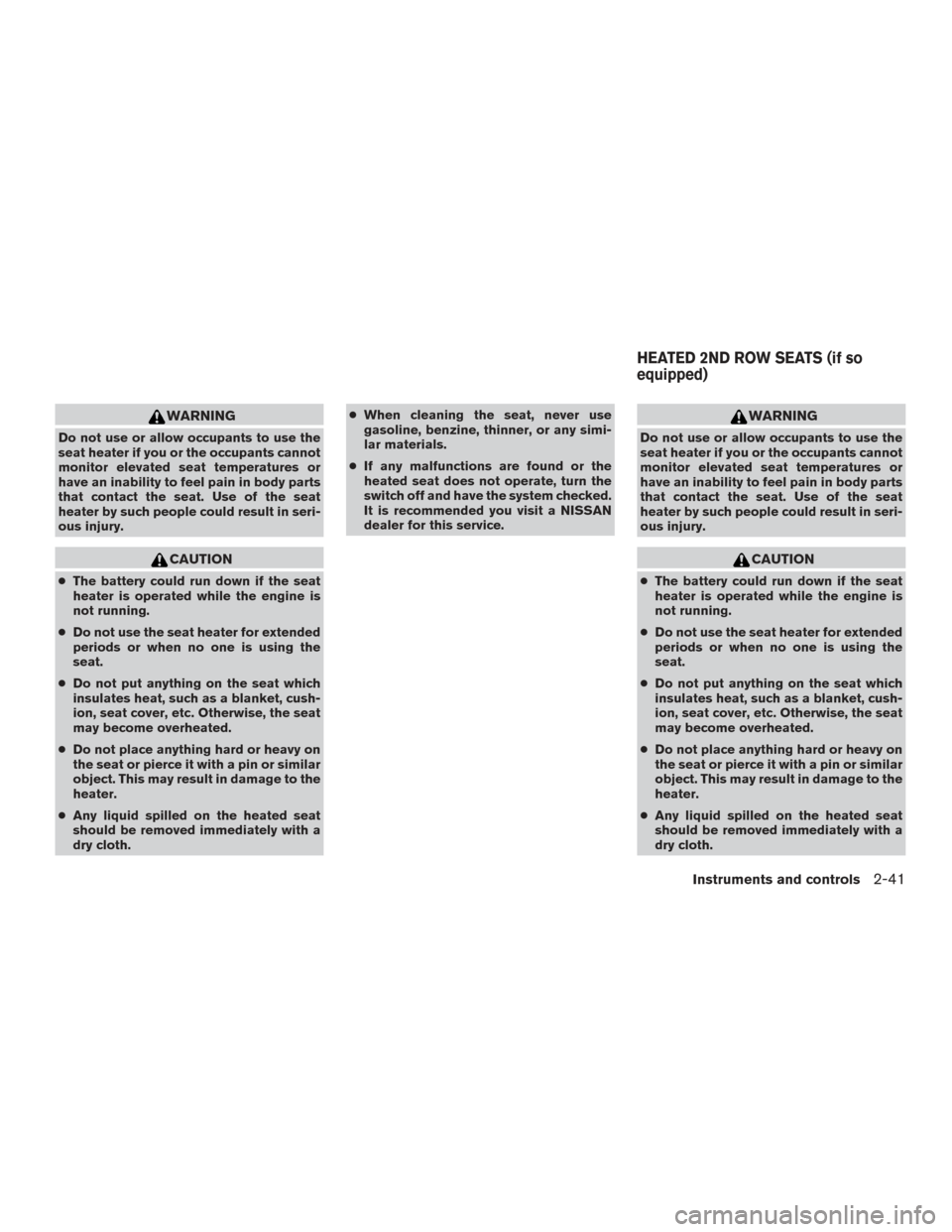
WARNING
Do not use or allow occupants to use the
seat heater if you or the occupants cannot
monitor elevated seat temperatures or
have an inability to feel pain in body parts
that contact the seat. Use of the seat
heater by such people could result in seri-
ous injury.
CAUTION
●The battery could run down if the seat
heater is operated while the engine is
not running.
● Do not use the seat heater for extended
periods or when no one is using the
seat.
● Do not put anything on the seat which
insulates heat, such as a blanket, cush-
ion, seat cover, etc. Otherwise, the seat
may become overheated.
● Do not place anything hard or heavy on
the seat or pierce it with a pin or similar
object. This may result in damage to the
heater.
● Any liquid spilled on the heated seat
should be removed immediately with a
dry cloth. ●
When cleaning the seat, never use
gasoline, benzine, thinner, or any simi-
lar materials.
● If any malfunctions are found or the
heated seat does not operate, turn the
switch off and have the system checked.
It is recommended you visit a NISSAN
dealer for this service.
WARNING
Do not use or allow occupants to use the
seat heater if you or the occupants cannot
monitor elevated seat temperatures or
have an inability to feel pain in body parts
that contact the seat. Use of the seat
heater by such people could result in seri-
ous injury.
CAUTION
● The battery could run down if the seat
heater is operated while the engine is
not running.
● Do not use the seat heater for extended
periods or when no one is using the
seat.
● Do not put anything on the seat which
insulates heat, such as a blanket, cush-
ion, seat cover, etc. Otherwise, the seat
may become overheated.
● Do not place anything hard or heavy on
the seat or pierce it with a pin or similar
object. This may result in damage to the
heater.
● Any liquid spilled on the heated seat
should be removed immediately with a
dry cloth.
HEATED 2ND ROW SEATS (if so
equipped)
Instruments and controls2-41
Page 131 of 540
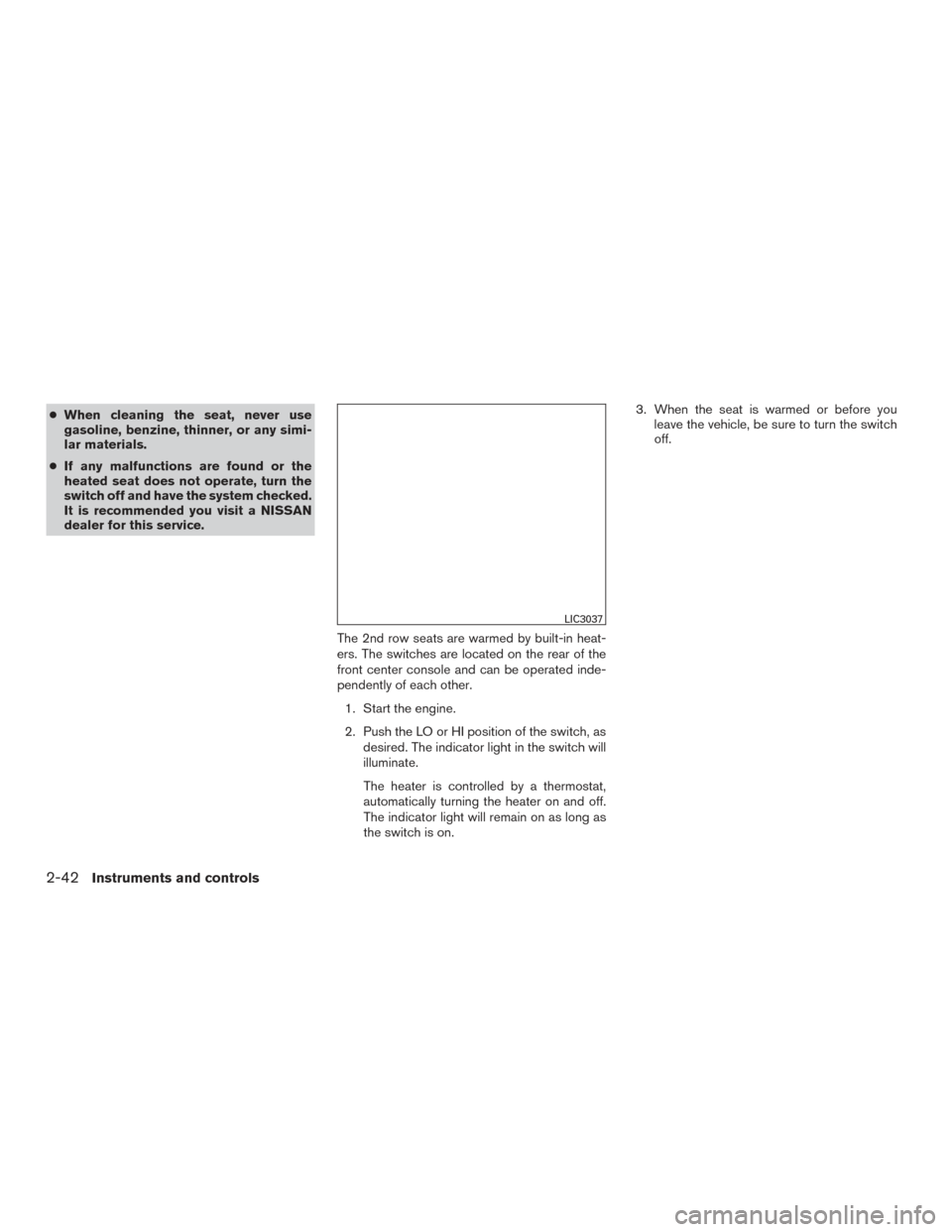
●When cleaning the seat, never use
gasoline, benzine, thinner, or any simi-
lar materials.
● If any malfunctions are found or the
heated seat does not operate, turn the
switch off and have the system checked.
It is recommended you visit a NISSAN
dealer for this service.
The 2nd row seats are warmed by built-in heat-
ers. The switches are located on the rear of the
front center console and can be operated inde-
pendently of each other.1. Start the engine.
2. Push the LO or HI position of the switch, as desired. The indicator light in the switch will
illuminate.
The heater is controlled by a thermostat,
automatically turning the heater on and off.
The indicator light will remain on as long as
the switch is on. 3. When the seat is warmed or before you
leave the vehicle, be sure to turn the switch
off.
LIC3037
2-42Instruments and controls
Page 195 of 540
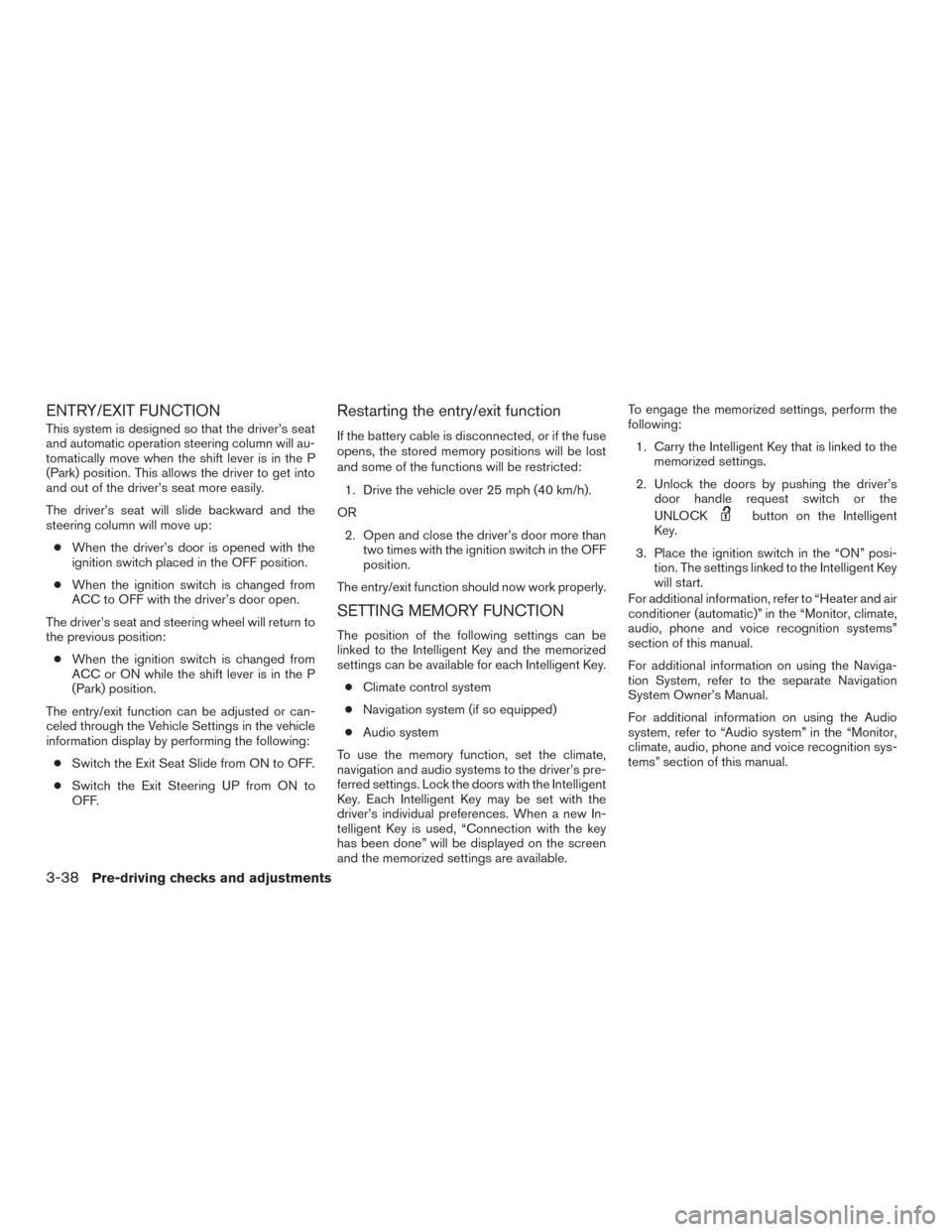
ENTRY/EXIT FUNCTION
This system is designed so that the driver’s seat
and automatic operation steering column will au-
tomatically move when the shift lever is in the P
(Park) position. This allows the driver to get into
and out of the driver’s seat more easily.
The driver’s seat will slide backward and the
steering column will move up:● When the driver’s door is opened with the
ignition switch placed in the OFF position.
● When the ignition switch is changed from
ACC to OFF with the driver’s door open.
The driver’s seat and steering wheel will return to
the previous position: ● When the ignition switch is changed from
ACC or ON while the shift lever is in the P
(Park) position.
The entry/exit function can be adjusted or can-
celed through the Vehicle Settings in the vehicle
information display by performing the following: ● Switch the Exit Seat Slide from ON to OFF.
● Switch the Exit Steering UP from ON to
OFF.
Restarting the entry/exit function
If the battery cable is disconnected, or if the fuse
opens, the stored memory positions will be lost
and some of the functions will be restricted:
1. Drive the vehicle over 25 mph (40 km/h).
OR 2. Open and close the driver’s door more than two times with the ignition switch in the OFF
position.
The entry/exit function should now work properly.
SETTING MEMORY FUNCTION
The position of the following settings can be
linked to the Intelligent Key and the memorized
settings can be available for each Intelligent Key. ● Climate control system
● Navigation system (if so equipped)
● Audio system
To use the memory function, set the climate,
navigation and audio systems to the driver’s pre-
ferred settings. Lock the doors with the Intelligent
Key. Each Intelligent Key may be set with the
driver’s individual preferences. When a new In-
telligent Key is used, “Connection with the key
has been done” will be displayed on the screen
and the memorized settings are available. To engage the memorized settings, perform the
following:
1. Carry the Intelligent Key that is linked to the memorized settings.
2. Unlock the doors by pushing the driver’s door handle request switch or the
UNLOCK
button on the Intelligent
Key.
3. Place the ignition switch in the “ON” posi- tion. The settings linked to the Intelligent Key
will start.
For additional information, refer to “Heater and air
conditioner (automatic)” in the “Monitor, climate,
audio, phone and voice recognition systems”
section of this manual.
For additional information on using the Naviga-
tion System, refer to the separate Navigation
System Owner’s Manual.
For additional information on using the Audio
system, refer to “Audio system” in the “Monitor,
climate, audio, phone and voice recognition sys-
tems” section of this manual.
3-38Pre-driving checks and adjustments
Page 198 of 540

4 Monitor, climate, audio, phone and voice
recognition systems
Control panel buttons — color screen without
Navigation System (if so equipped)..................4-4
How to use the NISSAN controller ...............4-5
How to select menus on the screen ..............4-6
How to use the STATUS button ..................4-6
How to use the INFO button .....................4-6
How to use the SETTING button .................4-8
OFF button..............................4-9
Control panel buttons — color screen with
Navigation System (if so equipped) .................4-10
How to use the NISSAN controller ..............4-12
How to use the touch-screen . . .................4-12
How to select menus on the screen .............4-14
How to use the STATUS button .................4-14
How to use the INFO button ....................4-15
How to use the SETTING button ................4-17
How to use the DISP button (if so equipped) .....4-19
How to use the CAMERA button ................4-20
OFF button............................. 4-20
Image viewer (if so equipped) ......................4-20
Using the image viewer ........................ 4-20
RearView Monitor (if so equipped) ..................4-22
RearView Monitor system operation .............4-23 How to read the displayed lines
.................4-23
Difference between predicted and actual
distances ..................................... 4-24
How to park with predicted course lines ..........4-25
Adjusting the screen ........................... 4-27
How to turn on and off predicted course
lines ......................................... 4-27
RearView Monitor system limitations .............4-28
System maintenance ........................... 4-29
Around View® Monitor (if so equipped) .............4-30
Around View® Monitor system operation .........4-31
Difference between predicted and actual
distances ..................................... 4-34
How to park with predicted course lines ..........4-36
How to switch the display ......................4-37
Adjusting the screen ........................... 4-38
Around View® Monitor system limitations ........4-38
System maintenance ........................... 4-40
Camera Aiding Sonar (parking sensor)
(if so equipped) .................................. 4-41
Vents ........................................... 4-42
Heater and air conditioner (automatic) (Type A)
(if so equipped) .................................. 4-43
Automatic operation ........................... 4-44
Page 199 of 540
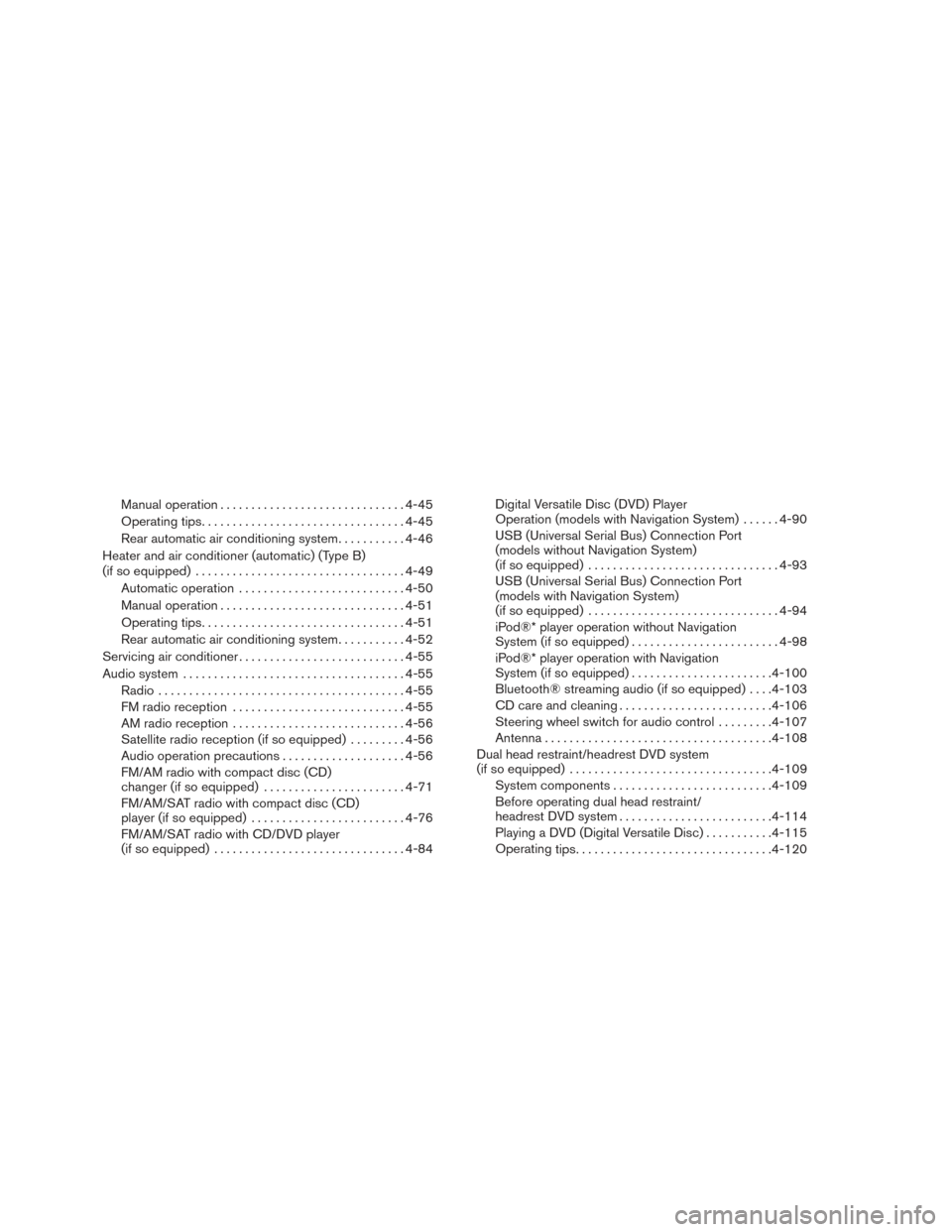
Manual operation.............................. 4-45
Operating tips ................................. 4-45
Rear automatic air conditioning system. . .........4-46
Heater and air conditioner (automatic) (Type B)
(if so equipped) .................................. 4-49
Automatic operation ........................... 4-50
Manual operation .............................. 4-51
Operating tips ................................. 4-51
Rear automatic air conditioning system. . .........4-52
Servicing air conditioner ........................... 4-55
Audio system .................................... 4-55
Radio ........................................ 4-55
FM radio reception ............................ 4-55
AM radio reception ............................ 4-56
Satellite radio reception (if so equipped) .........4-56
Audio operation precautions ....................4-56
FM/AM radio with compact disc (CD)
changer (if so equipped) .......................4-71
FM/AM/SAT radio with compact disc (CD)
player (if so equipped) ......................... 4-76
FM/AM/SAT radio with CD/DVD player
(if so equipped) ............................... 4-84Digital Versatile Disc (DVD) Player
Operation (models with Navigation System)
......4-90
USB (Universal Serial Bus) Connection Port
(models without Navigation System)
(if so equipped) ............................... 4-93
USB (Universal Serial Bus) Connection Port
(models with Navigation System)
(if so equipped) ............................... 4-94
iPod®* player operation without Navigation
System (if so equipped) ........................ 4-98
iPod®* player operation with Navigation
System (if so equipped) ....................... 4-100
Bluetooth® streaming audio (if so equipped) ....4-103
CD care and cleaning ......................... 4-106
Steering wheel switch for audio control .........4-107
Antenna ..................................... 4-108
Dual head restraint/headrest DVD system
(if so equipped) ................................. 4-109
System components .......................... 4-109
Before operating dual head restraint/
headrest DVD system ......................... 4-114
Playing a DVD (Digital Versatile Disc) ...........4-115
Operating
tips................................ 4-120